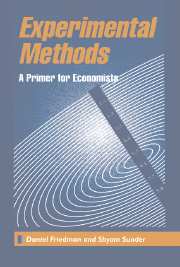Book contents
- Frontmatter
- Contents
- List of figures and tables
- Preface
- Acknowledgments
- EXPERIMENTAL METHODS
- 1 Introduction
- 2 Principles of economics experiments
- 3 Experimental design
- 4 Human Subjects
- 5 Laboratory facilities
- 6 Conducting an experiment
- 7 Data analysis
- 8 Reporting your results
- 9 The emergence of experimental economics
- Appendixes: Supplemental materials
- Glossary
- References
- Index
7 - Data analysis
Published online by Cambridge University Press: 05 June 2012
- Frontmatter
- Contents
- List of figures and tables
- Preface
- Acknowledgments
- EXPERIMENTAL METHODS
- 1 Introduction
- 2 Principles of economics experiments
- 3 Experimental design
- 4 Human Subjects
- 5 Laboratory facilities
- 6 Conducting an experiment
- 7 Data analysis
- 8 Reporting your results
- 9 The emergence of experimental economics
- Appendixes: Supplemental materials
- Glossary
- References
- Index
Summary
Imagine that you have just assembled the raw data from your recent experiments on market efficiency. You gaze at sheets of paper covered with numbers specifying which subjects did what and when they did it. Do the data support the efficient-markets hypothesis or not? You could stare at the raw data for hours and be none the wiser. It is time to begin your data analysis. You will transform and process the raw data in various ways to find out what they have to say. Think of data analysis as a form of interrogation. But be gentle – coax the data to tell their own story. You will learn very little if you torture the data until they confess.
This chapter introduces the basic tools for analyzing experimental data. Many experimentalists prefer a two-phase approach. The first phase is qualitative or descriptive and is intended to give an overview of what the data have to say. The tools are graphs and summary statistics. The second phase is more quantitative and is intended to give specific answers to specific questions. Here the tools are inferential statistics.
Experimental data and happenstance data raise the same general issues and require mostly the same analytical techniques, but there are notable differences in emphasis. Experimental data often come from newly created environments and are unlikely to be familiar to most readers, so the descriptive phase is particularly important. In most respects, statistical inference is quite straightforward for data obtained in well-designed experiments.
- Type
- Chapter
- Information
- Experimental MethodsA Primer for Economists, pp. 85 - 109Publisher: Cambridge University PressPrint publication year: 1994



